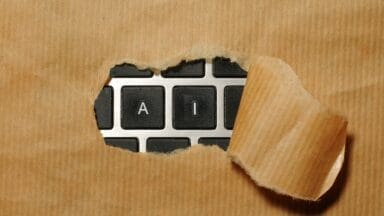
AI. Everyone is talking about it. Seemingly, everyone is also using it. Those who are using it are waxing lyrical about it; how it’s improved their business, marketing, manufacturing, customer service. For many, the increase in productivity and production, along with the ability to automate otherwise laborious administrative tasks has been a game changer.
At a recent conference, one pro-AI attendee stated, “AI doesn’t get sick, or take holidays”. Aside from the subtext of human collateral damage, on the surface it seems AI is the future.
In the gardening world who couldn’t argue the benefits of drones that water, devices which monitor plant health not to mention robots who do the pruning and weeding or tell us if our soil is healthy? AI might be the future, but what about the future of your IP? Whatever the sector, there is no escaping the computer-generated elephant in the room – ownership. Who owns the IP rights if you’re generating designs with AI? How do you stop AI using your designs and copyright works to generate new ones?
AI’s uses span the gamut of ground breaking and enabling, to its unauthorised use by machines using others’ IP with no regulation. Some may say ‘using’ is a sanitised word for stealing, the consequences of which threaten many with this sector. This rise on access to AI tools raises the question, will AI replace the traditional approach to designing? Are jobs on the line? Currently big business AI developers have written off the need for licensing so many ask, how will it be regulated? Some say, “We need to regulate AI before it regulates us!”
Text and data mining (TDM) is the process of scraping through information from computerised material and extracting the data from it. Generative AI tools are only able to produce content based on the knowledge with which they have been trained. Much of that trawled content is material that is subject to various IP rights, including copyright, trade marks, designs and patents.
Inevitably, the emergence of a plethora of legal cases will determine IP ownership, creating case law, but at what cost? Many in the UK’s creative industries are lone, micro or SME and, in the fast-moving world of designing new products, the cost and time prohibitive legal action to determine ownership is out of reach. For the majority this is not an option, but help may be at hand by some of the behemoths such as Disney bringing cases which help to define the law more clearly but this will take time. For example, Getty Images is suing the creators of AI art tool Stable Diffusion for scraping its content and a judgment will be made in June but the case has been going on since January 2023.
Currently works created by AI, even if produced from a text prompt written by a human, are NOT protected by copyright in the UK. UK copyright lasts, generally, for the life of the author plus 70 years. Copyright is created automatically in any work produced whether it is an artwork, painting, poem, sculpture or story. Under UK law you are automatically the owner in any work you produce. If you are employed, copyright belongs automatically to your employer.
The recent government AI and Copyright Consultation received a staggering and unprecedented 11,000+ responses, and the News Media Association’s MAKE IT FAIR campaign has brought IP in relation to AI right under the public microscope. The government’s consultation proposes to weaken copyright law and stymie the development of this market, sweeping the rug from under the creative industries that generate £126 billion to the UK economy and are a key component of our soft power abroad. Without fair payment, attribution or an easily accessible “opt out” system, high-quality creative content will become harder to make and this will also see generative AI innovation stall too, going against the government’s own ambitions for growth in this sector.
Much has been said by the government about the ‘uncertainty’ surrounding UK copyright law, but the law is clear: text and data mining – the method used to train generative AI models – is not allowed for commercial training purposes without a licence. The significant uncertainty is precisely who has already used the UK’s creative crown jewels as training material without paying for that use.
Proper control for creators is the only route which will allow them to continue producing the creative works that generative AI firms could then access through a transparent licensing model. We invite the government and the tech sector to partner with us in shaping a future that prioritises, safeguards and rewards the role of human creativity working together with AI in a win-win situation for all.
Whilst the Copyright and AI Consultation closed on 25th February, momentum must not be lost, and we urge all designers to think positively about how they can make their views known. ACID campaigns for designers’ rights, calling for transparency in AI training, fair recompense and respect for originality in creative works.
Act now
We recommend signing the ACID IP and AI Charter calling for respect, ethics and compliance. Send a letter to your MP (you can use our template). Communicate your disagreement with the government’s plan (you can use our social media assets) to push for easy to access licensing agreements that AI will be compelled to use if they plan to use your IP content.

